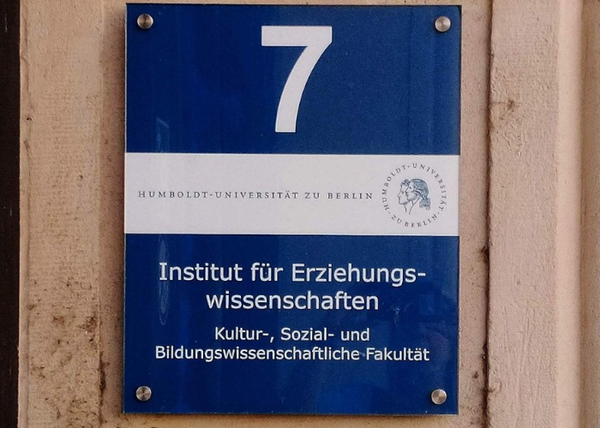The Archive - Origin and Development
This page documents the beginnings and further development in the first part. In the following part the items in the archive is briefly classified. Three photos help to illustrate the text by showing the location of the archive within the Humboldt university, the fries of the Haus des Lehrers and its former reading room.
1. Foundation and Inventory
Following the fall of the Berlin Wall, the Central Pedagogical Library's inventories from the Berlin House of the Teacher were to be destroyed. In the GDR era, the library was a significant gathering place for educators and is recognized throughout Europe. The building is constructed on the site of the former teachers' association house, which was established in 1908 at the beginning of the 20th century, prior to the First World War.
Upon hearing about this, the educational science professors at Humboldt University reacted promptly. They took immediate action by devising a plan. Its implementation could allow for the preservation of a significant portion of the existing inventory. Funds were applied for and received approved by the German Research Foundation called "Deutsche Forschungsgemeinschaft"(DFG). The Archive for Progressive Education was established as a result of this funding. It has been available for academic research and to interested laypeople since 1992. The Archive for Progressive Education has since occupied a regular spot at the Humboldt campus within the Institute of Education Studies in the center of Berlin, as shown in the following photo.

Fig. 1: HU Location Berlin-Mitte
The collection was formally inaugurated in the year 2000 following a period of extensive research into the theory and historical development of progressive education. For a considerable number of years, Dr. Horst Sladek had been in charge of the archive and played a significant role in its development. This initiative has also yielded numerous contacts and connections with other scientific archives and institutions, which continue to this day. The collection has been augmented over time through the acquisition of new items, donation and bequests. The majority of the documents are recorded in the database.
The teacher's house can still be found on Berlin's Alexanderplatz to this day. The high-rise building is immediately notable for its colourful frieze. The library, which comprised two floors, was located behind it (see photo).

Fig. 2: Frieze: Topic Education
The artistic composition entitled "Our Life" employs the stylistic conventions of socialist realism, utilising a visual narrative to portray scenes from the professional milieu within the context of the former German Democratic Republic. The upper part of the image illustrates the domains of education, encompassing research, instruction in the natural sciences, kindergarten and early education. The artwork was conceptualized and executed by the distinguished artist Walter Womacka.
The actual library, spanning two floors, was located behind the artwork. This library featured a reading area located on the fifth floor, as shown in the subsequent photograph.

Fig. 3: The Reading Room
The archive is often referred to as a collection of written documents. This includes primarily original texts, books, scholarly journals, and reproductions. Translations exist for the majority of the orignal documents. Conversely, a very small part includes photographs. There are alos exhibits from socialism and the Jugendweihe as well as drawings by students from the upper school for presentations available. The Jugendweihe was a secular youth initiation ceremony in the GDR.
2. Categorization of the Inventory
- Course books/ Curricula/ Grey Literature (GDR)
- Various writings from progressive, experimental and joint research schools
- Publications, e.g. dissertations and habilitations
- Academic journals and offprints
- Copies from other archives' collections
- Basic and reference works
- Exchange of correspondence between institutions, researchers, and private individuals
- Research documentation, such as minutes, protocols, reports, and circular letters
- Photos from East German school projects
- Student presentations on scientific and academic topics
- Laws and school regulations from the administration
- Academic surveys (PISA studies)
